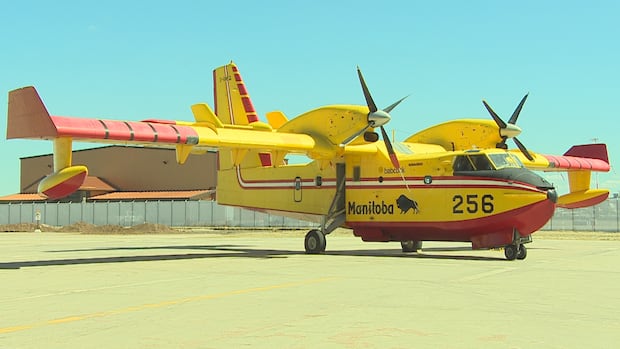Manitoba puts down payment of $80M on 3 new water bombers to fight forest fires
3 new DHC-515 aircraft will operate in Manitoba by 2032, province says
The provincial government is putting an $80-million down payment on three new water bombers it plans to have by the 2031 and 2032 fire seasons.
The new Calgary-made De Havilland Canadair 515 Firefighter water bombers will have upgraded navigation systems, increased tank capacity and more fuel-efficient engines, Premier Wab Kinew said on Friday.
The first water bomber is expected to join the fleet for the 2031 fire season, with the other two expected to be added in 2032, he said. The $80 million is a down payment and the full cost is still being negotiated, Kinew said.
"Every year we see some impacts, and some years there's huge, huge devastation to businesses, to properties and to people displaced … in some cases for extended periods," Kinew said.
"To have that quick response during wildfire season, to be able to have eyes in the sky, to be able to have water bombers at our disposal, it's absolutely critical."
The new bombers were promised within a decade in the provincial budget released last month.
The new water bombers will help fight fires not only in Manitoba, but in neighbouring provinces and territories and even south of Canada's border, Kinew said.
"No matter what's going on with the politicians between our two countries, we're still going to be good neighbours and we're still going to be there to help during times of need," he said.
Natural Resources Minister Ian Bushie said the additional aircraft will serve for decades and are integral to protecting communities and forests from the increasing frequency and severity of wildfires.
The Canadair 515 water bombers will replace three aged Canadair CL-215 water bombers, said Earl Simmons, executive director of Manitoba Conservation and Wildlife Service. The province has a total of seven water bombers.
"While these first-generation water bombers continue to keep Manitobans safe, the aircraft are near the end of their life, with engines that were developed in World War II," he said.
Richard Hristovski, deputy chief engineer at Babcock Canada, which maintains the CL-215s for the province, said the three water bombers have been operating for nearly 40 years.
While they can still be relied on to battle wildfires over the next six years, they have aging frames and their engines require a lot of maintenance, he said.
Simmons said he's not concerned about the ability of the province's existing water bombers to manage the upcoming wildfire season and continue to operate until the new aircraft are delivered.
Other 2025 budget commitments to firefighting include an additional $6.7 million for new equipment and systems, and $1.1 million over four years for a new weather information system, wildfire mapping and reporting systems, the release said.
The budget also doubled tax credits for volunteer firefighters and volunteer search and rescue members from $3,000 to $6,000.
With files from Matthew Humphrey


